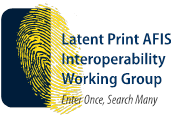Summary
Fingerprint records in one jurisdiction cannot always be compared to latent fingerprints left at the scene of a crime in another jurisdictions because their fingerprint search and comparison technology is not the same. NIST has developed standards to allow for interoperability among automated fingerprint identification systems (AFIS) as well as guidance on procuring compliant systems and sharing fingerprints across jurisdictions.
Description

Why is AFIS Interoperability Important?
Automated fingerprint identification systems (AFIS) allow latent print examiners to search fingerprint files and to transmit fingerprint images. However, examiners often lack the technological ability to access AFIS in neighboring jurisdictions. In addition, before submitting a print for an AFIS search, examiners must manually encode the print's features in a way that the system can understand. Unfortunately, this notation method is often different for various databases, requiring the examiner to re-encode each print before searching each AFIS, losing valuable time. This lack of latent print search interoperability and the subsequent missed opportunities to make identifications have been long recognized as serious issues within the examiner community.
Since the introduction of AFIS in the 1980s and the Federal Bureau of Investigation's Integrated Automated Fingerprint Identification System (IAFIS) in the late 1990s, some criminal justice agencies have had the ability to search latent prints not only against their own fingerprint database but also against a hierarchy of local, state, and federal databases. This hierarchical search is referred to as a vertical search process. However, the ability to search a neighboring city, county, or state database (i.e., a horizontal or peer-to-peer search) is nearly non-existent. These types of searches are both time-consuming and technically challenging due to the variety of vendors, communications links, and other issues.
The lack of AFIS interoperability is specifically addressed in the 2009 National Research Council's report, Strengthening Forensic Science in the United States: A Path Forward. Recommendation 12 of the report identifies the need "to launch a new broad-based effort to achieve nationwide fingerprint data interoperability" with a "task force comprising relevant experts from the National Institute of Standards and Technology and the major law enforcement agencies (including representatives from the local state, and federal, and, perhaps, international levels) and industry..."
In 2015, the National Science and Technology Council (NSTC) Subcommittee on Forensic Science recommended that all federal AFIS be compliant with interoperability standards within three years and that federal funds only be used in procurement of compliant systems.
The Latent Print AFIS Interoperability Working Group
Following the release of the NRC report, NIST directed resources toward addressing the issue of AFIS interoperability. Those efforts include development of technical standards and guidelines that would allow AFIS to interoperate. Outputs include:
- Data Format for the Interchange of Fingerprint, Facial & Other Biometric Information ANSI/NIST-ITL 1-2011 NIST Special Publication 500-290 Edition 3.
- Updates to the ANSI/NIST-ITL data interchange format standard were provided during its revision period that began in 2023, including recommendations to formally deprecate and remove proprietary vendor blocks from the Type 9 record type
- ELFT-EFS Evaluation of Latent Fingerprint Technologies: Extended Feature Sets
- Extended Features Set Profile Specification
- Latent Interoperability Transmission Specification
- Markup Instructions for Extended Friction Ridge Features
Guidance was also developed for organizations to use in procurement of systems that are compliant with the standard and for sharing information across jurisdictions:
- Writing Guidelines for Requests for Proposals for Automated Fingerprint Identification Systems
- Writing Guidelines to Develop a Memorandum of Understanding for Interoperable Automated Fingerprint Identification Systems
Additionally, tools were developed to test AFIS algorithms and to inspect an ANSI/NIST-ITL compatible record to see whether it uses standardized or proprietary images and feature encodings. NFIQ 2 allows one to assess the quality of fingerprint images stored in ANSI/NIST-ITL records; Bio-CTS is conformance testing software for ANSI/NIST-ITL records, including EFS feature sets, and the Biometric Evaluation Framework provides C++ APIs for parsing EFS encodings.
Some manufacturers now incorporate the interoperability standard in their products, and adoption by the community is the next step to bringing AFIS interoperability to fruition.

Resource Library
Documents
- Extended Feature Set Profile Specification – sets of features to be used in latent friction ridge (fingerprint, palmprint or plantar) searches of automated friction ridge identification systems (AFIS)
- Markup Instructions for Extended Friction Ridge Features – instructions for latent print examiners in marking friction ridge features to maximize consistency among examiners
- Latent Interoperability Transmission Specification – application profile of the American National Standards Institute/National Institute of Standards and Technology, Information Technology Laboratory (ANSI/NIST-ITL) standard entitled "American National Standard for Information Systems: Data Format for the Interchange of Fingerprint, Facial & Other Biometric Information" (ANSI/NIST-ITL 1-2011)
- DRAFT Glossary of AFIS Terms (PDF)
- Writing Guidelines for Requests for Proposals for Automated Fingerprint Identification Systems
- Writing Guidelines to Develop a Memorandum of Understanding for Interoperable Automated Fingerprint Identification System
NIST Software
- Friction Ridge Metadata Explorer – Web application that allows quick inspection of an ANSI/NIST-ITL compatible record to see if it uses standardized or proprietary images and feature encodings.
- Bio-CTS – Conformance testing software for ANSI/NIST-ITL records, including EFS feature sets.
- NFIQ 2 – Assess the quality of fingerprint images stored in ANSI/NIST-ITL records.
- Biometric Evaluation Framework – C++ APIs for parsing EFS encodings
Images

|

